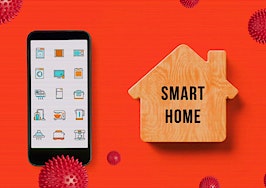I’ve learned a lot since diving head-first into smart home technology about four years ago. Since then, we’ve completely decked out our previous townhome, sold it, built a new house with loads of smart home tech and tested hundreds of products.
I probably spend way too much time reading articles, watching YouTube videos and learning more about smart homes, but it’s something I really enjoy. Along the way, I’ve met some really smart people who are doing incredible things.
In this series, I’ll be sharing some insights that should save you time and give you a better understanding of smart home tech. The following is from an email interview with Sean Gnant, who’s an incredible resource. His company, RGBgenie, is on the bleeding edge of lighting solutions, offering controllers and dimmers with a user-friendly, modern appearance and interface. Here’s what he had to say.
(Note: This interview was edited for grammar and style).
I’m setting up a smart home. Where is the best place to start?
As someone who fields calls every day from the DIY homeowner trying to make their places smarter, I have noticed a pattern of progression. Typically, a homeowner will buy a thermostat, and then Wi-Fi light bulbs, peanut plugs and switches.
Maybe they get a Wi-Fi garage door opener and a sprinkler timer. Then, they add in a handful of other devices, and next thing you know, they have a dozen apps on their phone. As a user, that gets old quick.
Then comes the realization that all of this needs to be combined. Because now you want your lights to come on when the garage door opens. You’re sick of all the apps, and nothing talks to each other. So, everyone eventually gets to the point where they start looking at hub platforms.
What do homeowners need to consider when choosing a hub?
In choosing a hub, you need to understand the four major protocols that most consumer-grade DIY platforms use: Wi-Fi, Bluetooth, Zigbee and Z-wave. All have their advantages and disadvantages.
Bluetooth, Zigbee and Z-wave are all mesh technologies where device commands are passed through other devices to extend the range. Wi-Fi devices, on the other hand, can only receive commands if within Wi-Fi range.
What are the limitations of using Wi-Fi-based devices?
People tend to overdo Wi-Fi devices. They should be limited to about 10 percent of your smart home install. Things like sprinkler timers, thermostats and garage door openers are often better to have on Wi-Fi as the corresponding app is usually superior to any hub interface.
But the last thing a homeowner should do is put a dozen bulbs and a dozen switches on their router. This often happens as users will start out using Wi-Fi to save on the expense of a hub. Their smart home grows, and next thing you know, they can’t stream Netflix anymore because of wireless traffic.
Your router’s DHCP server then decides to start reassigning the IP address, and now you can’t turn off your lights. This is a certainty if you have your Wi-Fi light bulb on a traditional wall switch.
It’s usually at this point that serious consideration is given to a centralized hub, and the learning curve associated with Zigbee and Z-wave devices begins.
Which is better: Z-Wave or Zigbee? And how do I set up a mesh network?
It’s best to succumb early to the fact that you will use both protocols. A device you need will not always be available in both. So, don’t be afraid to mix and match.
The main thing to understand is that both are mesh networks, and they require multiple devices to be stable. As a rule of thumb, devices that receive constant power are repeaters and can resend commands from your hub to other devices. These devices will be your backbone. So, the switch at the end of the house may get commands relayed through the living room outlet.
Battery-powered devices do not repeat signals and will do nothing to strengthen your mesh network. So, if a homeowner goes out and buys a dozen battery-powered window and door sensors but doesn’t have any other devices, they will struggle to stay connected to the hub. A common practice is to have one repeating device for every six battery-powered devices.
Another factor to consider is the mobility of the devices you are adding. Light switches and outlets will not move and are the best devices for creating a stable mesh backbone. Peanut-style plugs and light bulbs are weaker repeaters and tend to move around.
One thing that makes a mesh backbone stable is when the hub can rely on devices remaining online and in place. Devices having consistent neighbors will virtually eliminate dropped or misdirected packets.
A common mistake is having a smart light bulb on a traditional wall switch. Everyone does it. I still have them. The problem is this will drop that device in and out of the network. Other devices dependent on receiving commands through that bulb may no longer function if the switch is off.
Here’s a tip. If you’re going to use a bulb in a place where a switch will also control it, then get Sengled Zigbee bulbs. They do not have a repeater, which is helpful to the mesh.
So that couch lamp people still use the switch to turn off (like I have)? Set the bulb to always come on after power is restored, and it will also act as a traditional bulb. But of course, it will have no smart control if the switch is off.
In both Zigbee and Z-wave platforms, there are inexpensive products that often do more harm than good to the mesh network you’re trying to create. So, if a homeowner is the type where they invest as little as possible, their smart home will most likely struggle. A willingness to pay an extra few bucks and 15 minutes of research will go a long way towards home automation happiness.
When might you not want to use either Zigbee or Z-wave?
Having an understanding of what makes a good Zigbee or Z-wave mesh network will ironically lead you back to Wi-Fi devices — because they do have their place.
For example, it would be better to get Wi-Fi power strips for the Halloween display you put up every year. The reason is you want to keep devices off your Zigbee and Z-Wave mesh network that are intermittently used or moved around. Nothing wrong with going Wi-Fi in a situation like this.
Why should I consider local control?
There are only two types of computers in the world — your computers and other people’s computers. So, in thinking through platform choices, at every instance, choose local control.
The reason for doing so isn’t for superior system reliability (which it has), but instead, that all cloud-based devices are reliant on user agreements that can and will change at the last second. Often, that change is the bankruptcy of the company, and now nothing works.
Just think if a company like Wink went out of business, which is not far-fetched. Every unit on the market would be a brick. Hubitat, on the other hand, is 100 percent locally controlled through your home network.
Same thing with Rachio. If they forgot to pay their Amazon web service bill, you’re out of luck. RainMachine, on the other hand, will keep on ticking as it’s also locally controlled.
There is no safety with large companies either. Nest did their customers wrong when they fire-walled their products from being used on other systems. Could you imagine if you bought a tire for your car and through some type of “upgrade” the bolt pattern no longer fit and you couldn’t use it? This is what’s happening in home automation and why your system needs to stay off of other people’s computers.
Brandon Doyle is a Realtor at Doyle Real Estate Team — RE/MAX Results in Minneapolis and co-author of Mindset, Methods & Metrics – Winning as a Modern Real Estate Agent. You can follow him on Twitter.













